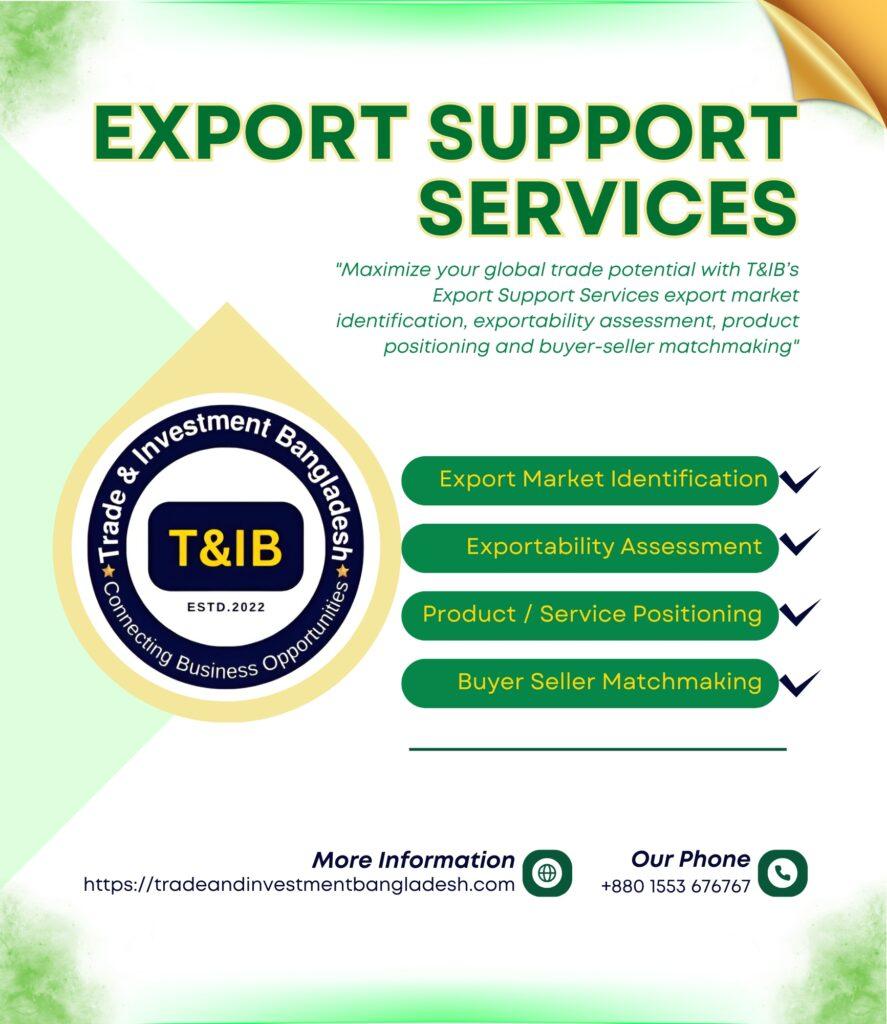Leveraging Technology for Export Growth in Bangladesh
Founder & CEO, Trade & Investment Bangladesh (T&IB)
Executive Director, Online Training Academy (OTA)
Secretary General, Brazil Bangladesh Chamber of Commerce & Industry (BBCCI)
Bangladesh’s economy has experienced remarkable growth over the past two decades, with exports playing a pivotal role most notably in the ready-made garment (RMG) sector, which accounts for over 84% of the country’s total export earnings. However, in a rapidly changing global trade landscape shaped by digitalization, automation, and advanced analytics, there is an urgent need to integrate technology more deeply into the export ecosystem. According to the Export Promotion Bureau (EPB), Bangladesh’s total exports reached USD 55.56 billion in FY 2022–23, reflecting steady progress, yet still far behind regional competitors like Vietnam, which exported over USD 370 billion in the same period. This gap underscores the potential of technological adoption to diversify export baskets, enhance productivity, ensure quality compliance, and access new markets. By embracing Industry 4.0 technologies, expanding digital trade infrastructure, and fostering tech-driven innovation, Bangladesh can unlock new opportunities for sustainable and inclusive export growth.
1. Unlocking New Markets and Opportunities
Bangladesh’s export industry has made impressive strides in recent years, evolving from a primarily textile-driven economy to one with emerging capabilities in sectors like pharmaceuticals, IT services, leather goods, and agro-processing. The country’s strategic geographic location, abundant labor force, and trade privileges such as duty-free access to the European Union under the Everything But Arms (EBA) initiative have contributed to this progress. Yet, despite these advantages, the scope for further growth remains vast. For example, while Bangladesh’s exports crossed USD 55 billion in FY 2022–23, its share in global trade is still less than 0.2%, indicating significant untapped potential in both traditional and non-traditional markets.
However, Bangladeshi exporters face several persistent challenges. These include limited diversification of export destinations, heavy reliance on a few sectors, complex regulatory environments, inadequate logistics and infrastructure, and stiff competition from countries like Vietnam, India, and China. Moreover, non-tariff barriers and lack of familiarity with international standards often hinder market entry, especially in high-income countries.
This is where technology emerges as a transformative force. By leveraging digital platforms, e-commerce, and data-driven market intelligence, Bangladeshi businesses can reach customers in previously inaccessible markets. Technologies like blockchain and AI can simplify supply chain management and enhance transparency, increasing trust among international buyers. Virtual trade fairs, B2B portals, and digital marketing enable small and medium enterprises (SMEs) to promote their products globally without the high costs of traditional marketing channels. Additionally, the adoption of advanced manufacturing technologies can help meet international quality and compliance standards, making Bangladeshi products more competitive in global markets. As global trade continues to digitize, integrating these tools can significantly expand Bangladesh’s export footprint and create pathways for long-term, sustainable growth.
2. Leveraging E-commerce Platforms
The rise of global e-commerce platforms has created unprecedented opportunities for exporters in developing countries like Bangladesh to access international markets with lower entry barriers. Platforms such as Alibaba, Amazon, eBay, Etsy, and Daraz Global have become vital channels for cross-border trade, enabling even small and medium enterprises (SMEs) to showcase their products to millions of global consumers. For Bangladeshi exporters especially those dealing in handicrafts, apparel, leather goods, jute products, and home décor these platforms offer a cost-effective, scalable, and direct path to foreign buyers.
To succeed in the global e-commerce space, Bangladeshi businesses must invest in building a strong online presence. This involves creating professional product listings with high-quality images, compelling descriptions, competitive pricing, and clear branding. Understanding platform-specific algorithms, optimizing for keywords, managing reviews, and providing reliable customer service are equally important to maintain visibility and trust. Additionally, aligning with global fulfillment standards such as timely shipping, secure packaging, and easy returns—can significantly enhance buyer satisfaction and repeat business.
Several Bangladeshi companies have already found success by tapping into the global e-commerce ecosystem. For instance, Bohurupi, a local artisan brand, gained international attention through Etsy by offering hand-crafted jewelry and home items rooted in Bengali tradition. Similarly, Zaynax Health, originally focused on health tech, leveraged Amazon to export wellness products like herbal supplements to the U.S. market. Leatherex Footwear Industries Ltd. and Aarong Earth have also explored e-commerce as a strategic channel to complement their traditional export models, reaching niche markets in Europe and North America.
These examples underscore the transformative potential of digital trade for Bangladeshi exporters. With the right strategy, training, and infrastructure, more businesses can harness the power of e-commerce to diversify their markets, increase revenues, and contribute to the country’s broader export-led growth agenda.

3. Streamlining Operations and Efficiency
As global trade becomes more competitive and customer expectations rise, operational efficiency is no longer a luxury it’s a necessity. For Bangladeshi exporters, especially those managing growing order volumes and complex supply chains, leveraging technology to streamline operations can significantly enhance their competitiveness. From inventory tracking to order fulfillment and logistics coordination, digital tools offer powerful ways to automate routine tasks, minimize errors, and accelerate delivery timelines.
Technologies such as automated inventory management systems help businesses maintain optimal stock levels, reduce wastage, and respond quickly to market demand. Order fulfillment platforms integrated with logistics services can automate shipping label creation, track parcels in real time, and notify customers throughout the process. Moreover, cloud-based Enterprise Resource Planning (ERP) and Customer Relationship Management (CRM) systems centralize key business functions ranging from finance and procurement to sales and customer support enabling better data-driven decisions and seamless collaboration across departments.
For instance, a Bangladeshi garment exporter using an ERP system can monitor production schedules, manage raw material procurement, and track export documentation from a single dashboard. Similarly, a CRM platform helps maintain detailed customer profiles, track communication history, and deliver personalized support improving customer satisfaction and loyalty in competitive global markets.
Digitization not only simplifies complex operations but also delivers tangible benefits: reduced administrative and operational costs, faster turnaround times, fewer errors, and increased overall productivity. These improvements translate into better compliance with international standards, more timely deliveries, and higher buyer confidence all critical factors for sustained export growth. By embracing these technological solutions, Bangladeshi exporters can scale more efficiently, adapt quickly to changing market demands, and position themselves as reliable players in the global value chain.
4. Embracing Digital Marketing and Social Media
In the digital age, a strong online brand presence is essential for any exporter seeking to compete on the global stage. For Bangladeshi businesses, digital marketing offers a powerful and cost-effective way to build brand identity, reach new customers, and promote products beyond traditional trade channels. The first step in this journey is developing a professional, mobile-friendly website serving as a virtual storefront that showcases the brand, product offerings, company values, and contact information. Investing in Search Engine Optimization (SEO) ensures that the website ranks high on search engines, making it easier for potential buyers to discover the business organically.
In addition to a robust website, social media platforms like Facebook, Instagram, LinkedIn, and YouTube have become indispensable tools for engaging with international audiences. Facebook and Instagram are ideal for visually-driven consumer products such as apparel, handicrafts, and home décor, allowing exporters to post product showcases, behind-the-scenes stories, and customer testimonials. Meanwhile, LinkedIn provides a more professional space to connect with B2B clients, distributors, and buyers in industries such as IT services, manufacturing, or pharmaceuticals.
One of the most impactful tools in modern marketing is targeted digital advertising. Platforms like Facebook Ads, Google Ads, and LinkedIn Campaign Manager allow businesses to reach specific demographics, geographies, and industries based on user behavior and interests. For instance, a leather goods exporter from Bangladesh can run a targeted ad campaign to reach fashion buyers in Germany aged 25–45, increasing the likelihood of converting views into sales or inquiries. These campaigns offer real-time analytics, allowing businesses to fine-tune their approach and maximize return on investment.
By embracing digital marketing and social media, Bangladeshi exporters can not only build brand awareness but also foster trust, gather customer feedback, and create long-term engagement with global markets. In an era where online visibility is key to international success, this digital outreach is no longer optional it is a vital pillar of any modern export strategy.

5. The Future of Export in Bangladesh: A Technology-Driven Vision
As global trade evolves at a rapid pace, the future of Bangladesh’s export industry will be increasingly defined by its ability to harness emerging technologies. The traditional reliance on low-cost labor and limited product categories is no longer sufficient to sustain long-term growth. To remain competitive in a dynamic global marketplace, Bangladesh must embrace a forward-looking, technology-driven export model one that leverages innovation to boost efficiency, ensure quality, and unlock new opportunities.
Technologies such as blockchain and artificial intelligence (AI) are already beginning to reshape international trade. Blockchain can provide transparent and tamper-proof supply chains, enabling Bangladeshi exporters to build trust with global buyers by offering traceability of goods from raw materials to final delivery. This is particularly valuable in sectors like textiles, agro-products, and pharmaceuticals, where compliance and authenticity are critical. On the other hand, AI-powered tools can assist in demand forecasting, dynamic pricing, quality control, and customer behavior analysis, helping businesses make smarter, faster decisions.
Moreover, the continued rise of 3D printing, Internet of Things (IoT), and robotics will further influence manufacturing and logistics, enabling mass customization and predictive maintenance areas where Bangladeshi exporters can innovate to offer differentiated value in global markets.
However, the adoption of technology must go hand in hand with a culture of continuous innovation, skills development, and policy support. Exporters will need to invest in workforce training, upgrade digital infrastructure, and collaborate with tech startups and research institutions to stay ahead of the curve. Government agencies and trade bodies must also play a proactive role in facilitating digital transformation through incentives, partnerships, and regulatory modernization.
Ultimately, the future of Bangladesh’s exports lies not only in what it produces, but how it produces, markets, and delivers those products using technology. By embracing this vision, Bangladesh can move beyond being a low-cost manufacturing hub to becoming a resilient, smart, and high-value exporter in the global economy.
Closing Remarks:
As Bangladesh strives to expand and diversify its export base, the integration of technology across all levels of the export ecosystem is no longer optional it is essential. From digital marketing and e-commerce to cloud-based operations and AI-driven analytics, technological tools offer Bangladeshi businesses the means to increase efficiency, reduce costs, and access previously unreachable markets. Embracing innovation will not only enable exporters to meet evolving global standards but also position Bangladesh as a modern, adaptable player in international trade.
However, the path forward requires a collaborative effort. Exporters must be proactive in adopting new technologies, investing in digital infrastructure, and building the skills necessary to compete globally. At the same time, government institutions, trade bodies, and financial organizations must create an enabling environment through supportive policies, capacity-building programs, and access to affordable digital tools. Without these foundational efforts, the benefits of technology will remain limited to only a few sectors or businesses.
Bangladesh has already demonstrated its potential as a rising export powerhouse. By fully leveraging the transformative power of technology, the country can accelerate its journey toward sustainable, inclusive, and innovation-driven export growth. The future belongs to those who can adapt, evolve, and lead and with the right strategy, Bangladesh is well-positioned to do just that.


